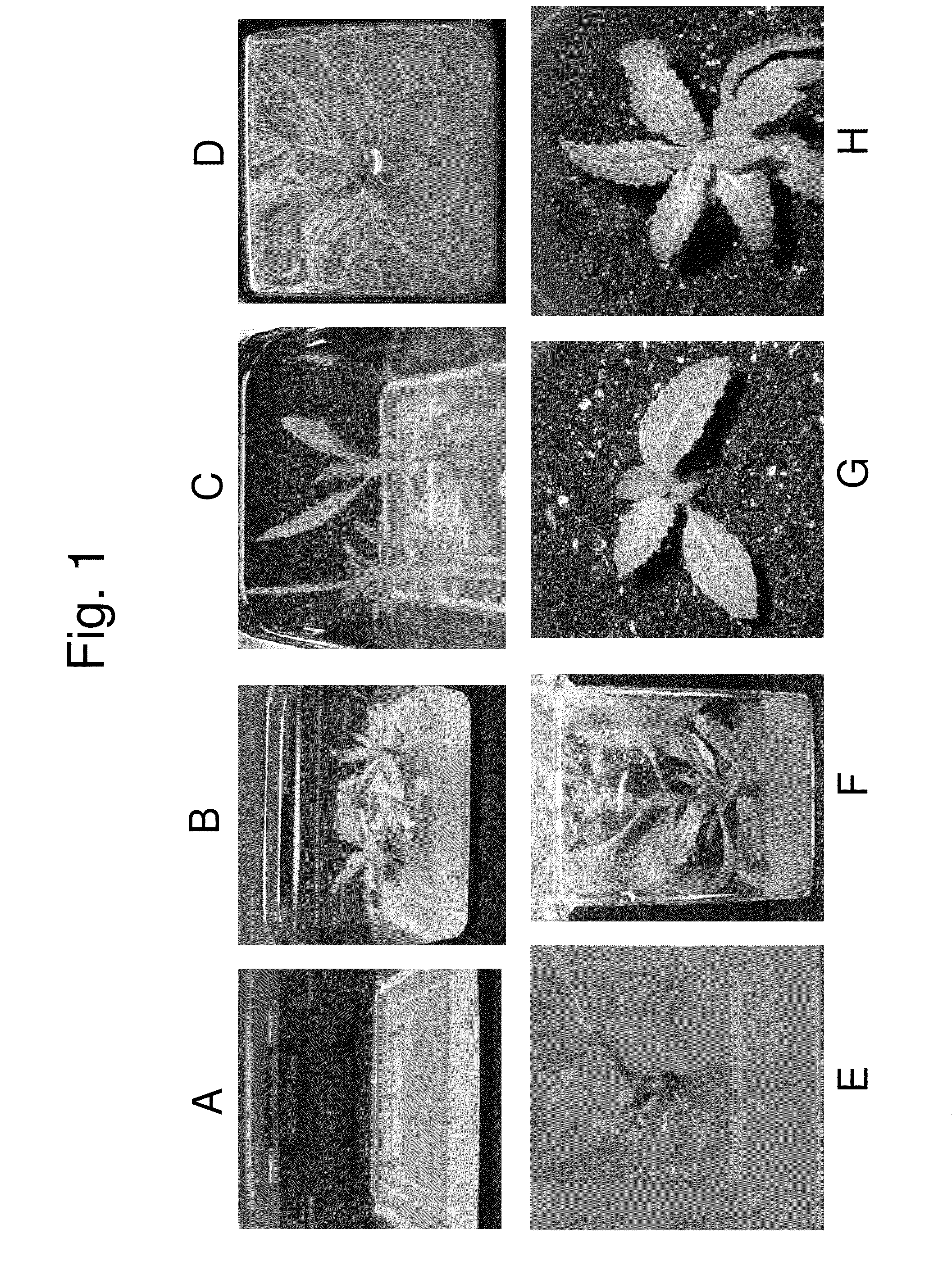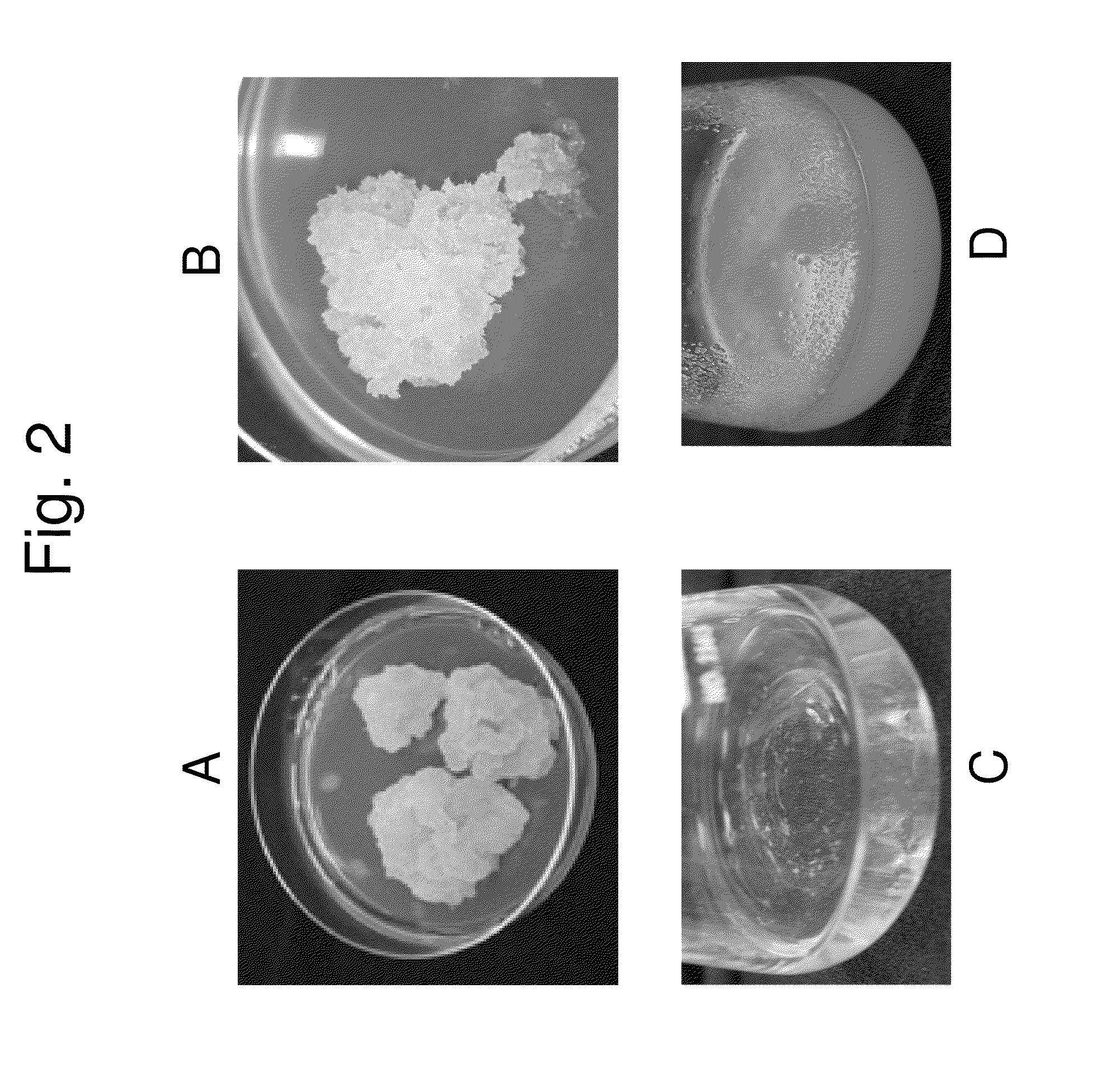Uses for Yerba Santa
a technology of yerba santa and yerba santa, which is applied in the directions of viruses, peptide/protein ingredients, plant/algae/fungi/lichens ingredients, etc., can solve the problems of inability to achieve in vitro propagation and tissue culture techniques, and the use of biotechnological tools in medicinal plant science is limited, so as to induce an immune response
- Summary
- Abstract
- Description
- Claims
- Application Information
AI Technical Summary
Benefits of technology
Problems solved by technology
Method used
Image
Examples
example 1
[0087]In Vitro Propagation and Root Induction
[0088]For establishment of in vitro cultures stem segments with nodes of three Yerba Santa species (Eriodictyon californicum, Eriodictyon sessilifolium, and Eriodictyon trichocalyx) are used as primary explants. They are washed, surface sterilized and placed on MS medium (Murashige T& Skoog F. (1962) Physiol Plant 15:473-497) supplemented with different cytokinins: N6-benzylaminopurine (BAP), zeatin, and kinetin. All three Yerba Santa species propagate in vitro most efficiently on basal MS medium supplemented with 1 mg / l zeatin. During 6 weeks a significant number of shoots are produced for all three species. Comparison of the shoot propagation capacity of three species of Yerba Santa demonstrates the highest efficiency in E. trichocalyx (FIGS. 1, A and B), about 8-10 shoots are produced from each explant in 4-5 weeks. A single explant of this species can produce thousands of shoots in 3-4 months.
[0089]Individual shoots are excised and tr...
example 2
[0090]Establishment of Cell Suspensions
[0091]To obtain a rapidly growing cell suspension culture, three Yerba Santa species are screened for callus induction and cultivation. Callus tissues are initiated for all three Yerba Santa species from leaf explants on callus induction media MSC-1 after 4-6 weeks of incubation in darkness. For future propagation, callus tissues are transferred to MSC-2 medium. After 6-8 weeks of cultivation on MSC-2 medium, the callus of E. trichocalyx showed the best growth capacities (FIG. 2A) E. californicum also demonstrated good growth capacity, however some part of the callus tissues showed browning (FIG. 2B).
[0092]Cell suspensions of Yerba Santa species are established from callus tissues in liquid media MSS. E. trichocalyx show the best results, including fast growth rates of cells, no browning of cells, and mild cell aggregations (FIGS. 2C and 2D). The E. trichocalyx cell suspension is very fast growing: about a 10-12-fold increase in cell volume is ...
example 3
[0093]Transformation of Yerba Santa
[0094]As a first step in the development of an efficient transformation system, the development of an efficient regeneration system is initiated. Preliminary experiments using different media compositions and types of explants indicate that shoots from several Yerba Santa species regenerate most efficiently on MSR medium (Table 1) and that leaf segments have the best regeneration potential. During 5-6 weeks leaf explants produce multiple shoots on MSR medium through direct regeneration without callus formation. Comparison of the regeneration capacity of three species (E. californicum, E. sessilifolium, and E. trichocalyx) reveal the highest regeneration efficiency in E. trichocalyx leaf segments reaching 75%-82% (FIG. 4; FIGS. 5A and 5B). Based on the results of regeneration experiments, leaf segments of E. trichocalyx are chosen as explants for transformation experiments.
[0095]Preliminary transformation experiments reveal several challenges associ...
PUM
| Property | Measurement | Unit |
|---|---|---|
| weight | aaaaa | aaaaa |
| concentration | aaaaa | aaaaa |
| concentration | aaaaa | aaaaa |
Abstract
Description
Claims
Application Information
 Login to View More
Login to View More - R&D
- Intellectual Property
- Life Sciences
- Materials
- Tech Scout
- Unparalleled Data Quality
- Higher Quality Content
- 60% Fewer Hallucinations
Browse by: Latest US Patents, China's latest patents, Technical Efficacy Thesaurus, Application Domain, Technology Topic, Popular Technical Reports.
© 2025 PatSnap. All rights reserved.Legal|Privacy policy|Modern Slavery Act Transparency Statement|Sitemap|About US| Contact US: help@patsnap.com



